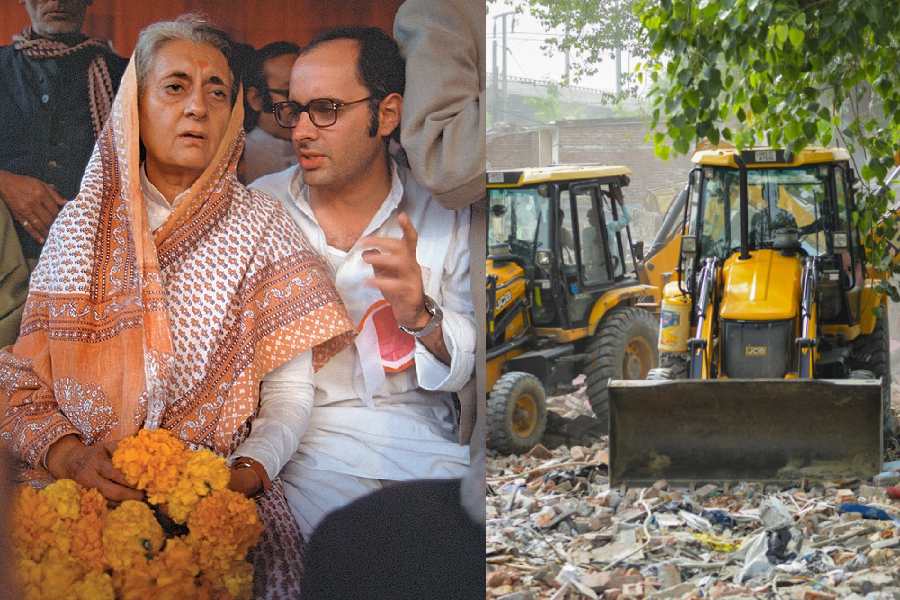 |
The Shahid Minar rises like a fluted candlestick in the heart of the city, adorning the skyline like no skyscraper ever can. Calcuttans have given it another name – a dak naam – “Monument”. We love it, we take pride in it, we point it out to a visiting cousin and we can’t think of Calcutta without it. But do we visit it?
I hadn’t, despite living in the city all my life, and neither has anyone I know. So, I decided to climb to the top of the Monument. Before I set off, like any good tourist, I googled it. It turns out you can’t just go climb the Shahid Minar. You need permission from the Lalbazar police headquarters. Shahid Minar is open to the people only on the second and third weeks of a month. The other two weeks are dedicated to its maintenance.
Okay, that somewhat explains why people don’t climb the 157ft Minar more often. But wouldn’t it take me a lot more paperwork and a huge hole in my pocket to climb the Arc de Triomphe in Paris, which is almost the exact height as our Monument?
The officers at Lalbazar were helpful and I got the permission easily.
I stood at the foot of Shahid Minar, so re-named in the 1960s in honour of our freedom fighters, and gazed up at the white column, marvelling at its imposing structure. It is a rare combination of three architectural styles. The base is Egyptian, the column Syrian while the dome with its metal cupola is typically Turkish.
A guard let me into the grassy enclosure at the foot of the Minar. A policeman welcomed me and wished me luck. The column has a spiral staircase, 198 steps to the lower balcony and another 25 to the top.
I stepped into the mouth of the staircase and gazed up. Darkness. There are no electric lights inside the Minar, but natural light streams in from shafts at regular intervals. I kicked myself for not bringing a flashlight. I could hear the cooing of pigeons inside the dark column. I almost turned back.
The policeman agreed to accompany me for the first 20-odd steps, till the first window. He led the way. It’s a corkscrew staircase and one needs to tread carefully, more so to avoid nests holding pigeon eggs. But there are no bats, simply because there’s no place to hang.
We reached the first light perforation on the wall, where the golden rays of the sun cut the darkness like a knife. It was time for the kind cop to leave, but we had a problem. The staircase is just one person wide, unless of course you are Kate Moss (the original size zero). The cop couldn’t climb down unless I did. So, up we went. The climb was arduous but not exhausting.
And then we stepped into the lower balcony, and took in the fresh air in great gulps. The breeze was cool and refreshing.
And the view… it was worth every aching muscle in my body, worth the darkness and the grime. My eyes feasted on the green expanse down below — the light green of the Maidan and dark green pools formed by clumps of trees. One notices the buildings much later. But almost all landmarks in the heart of Calcutta and beyond are visible. The balcony is circular, and I slowly walked the circumference of the Minar, spotting Victoria Memorial, Vidyasagar Setu, the peak of New Market, Assembly House, High Court, the dome of the GPO, Eden Gardens and Howrah bridge. On the eastern side, the Indian Museum rose magnificently, its white columns gleaming in the late afternoon sun. It’s a rare sight now, lost forever from the ground ever since the construction of the Park Street flyover.
We then climbed the last 25 steps to the upper balcony. The steps got narrower as we gained height and we had to place our feet delicately. Standing at the top of the Minar, I could now see the river, a thin strip on the western side. The breeze was sharper here.
“So, this is what the fairy atop Victoria Memorial must feel like,” I thought to myself.
Above us, the dome of the Minar rose like a giant white lotus. I stood there a long time, much beyond the 30 minutes stamped on my visitor’s pass. The climb down was harder, but the prospect of an angry pigeon flying into my face distracted me enough not to pay heed to my aching knees.
Climbing the Shahid Minar turned out to be much more of an adventure than I had imagined it would be, thanks to the public works department, which is in charge of its upkeep. The caretaker said the place would be renovated “soon”; when that will be is anybody’s guess.
But maybe we, the citizens of Calcutta, can make a difference. If we visit the “cloud-kissing monument” (as Mark Twain referred to it) in droves, the authorities are bound to sit up and take note. They will be forced to clean the staircase daily and clear the two balconies of plants that are driving roots into the structure.
They could put up a stall on the lawns and sell souvenirs — miniature Minar keyrings, refrigerator magnets, postcards, T-shirts, caps, guidebooks, maps — the possibilities are endless. All it takes is a little thought for out tallest totem.
fact file
■ The Shahid Minar was formerly known as the Ochterlony Monument, built in 1828 in memory of Major-general David Ochterlony after he won the Nepalese war for the British.
■ It was built by J.P. Parker from the design of Charles Knowles.
■ The cost was Rs 35,000, raised through public subscription.
■ Mackintosh Burn Ltd was the contractor.
■ The custom of convening political seminars at the Monument started in 1931 when Rabindranath Tagore presided over a convention to condemn the killing of a youth in Hijli by the British.
Tourist tips:
► For permission contact the office of the assistant commissioner of police (headquarters). Ph: (033) 22505319/ 22505051.
► Take along a photo ID and address proof and a photocopy of each. Apply for permission a day or two ahead of your intended visit. Outstation visitors need a document from their hotel/guesthouse.
►Carry a flashlight and water and wear comfortable shoes
► Camera and umbrella not allowed
►The climb is not advisable for the fat and not-so-fit
lNearest Metro station: Esplanade; nearest bus stop: Dorina crossing










